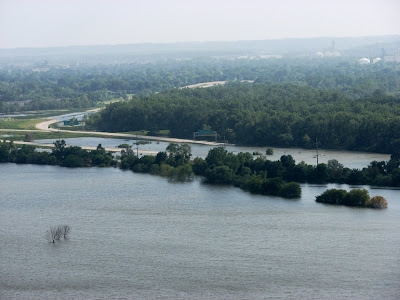I wanted to post a follow up to my earlier post so that readers can better understand the mind-boggling magnitude of this event. Here is a gallery of pictures of the flooding:
http://www.ncnewspress.com/photos/x437339674/Photo-gallery-Missouri-River-flooding-2011?page=0
It is truly huge and I don't think it's an exaggeration to say that hundreds of thousands of people have been adversely affected. The victims are generally not wealthy people with expensive riverfront properties, whining because they don't have flood insurance. Many, if not most, are rural or lower middle class working people who live in small homes or even trailer parks. The businesses are not big box retailers but convenience stores and restaurants located near the river or interstate, who struggle in the best of times. In addition, many of the locations are not considered to be in the Missouri River flood plain, but as in the case of my family members, miles from the river itself.
I personally know two families that have been driven from their homes since June. My afore-mentioned relatives are living in a travel trailer for the foreseeable future. They, along with their neighbors, spent their own money to build a temporarly levee around their houses, and moved nearly all of their belongings into storage for the duration of the flood. So far their homes are dry but are still threatened and considered too dangerous to occupy. The other family, fortunately, has not seen their home inundated, but their access road is underwater, and they are renting a place to live in until they can return.
These are just two examples out of thousands. Some of those impacted have stayed in their houses, although their basements are full of water and mold. Council Bluffs in particular is home to many poor working-class people who are being severely stressed by the flooding.
It is difficult to understand why this story has not become prominent in the national media given its scope and the amount of money it is costing ordinary families.
Saturday, August 6, 2011
Nowhere To Turn For Victims of Months-long, Government-caused Disaster
You may be forgiven for not knowing much about the catastrophic Missouri River flooding that has caused billions of dollars in damage, closed interstate highways for months, and driven thousands of people from their homes. The only time it garnered national attention was when it appeared that a local nuclear power plant might be damaged by floodwaters. A cynical person might wonder if the national media was hoping for a dangerous radiation leak, in order to highlight the risks of nuclear energy. Fortunately, no catastrophe resulted from that incident, since the plant was already shut down.
 |
| Flooded farms and businesses |
It all started in early June, when the Army Corps of Engineers anounced that it would be increasing water releases from dams located upstream, in Montana and South Dakota, to up to three times the normal flows. The releases were needed to accommodate heavy rainfall upstream, as well as higher than normal snowmelt. Residents of affected areas were warned to evacuate their homes, including some of my family members who live six miles from the river (their location was threatened by nearby creeks backing up since normal flows into the Missouri would be prevented by the high water levels). Evacuees were instructed to prepare for months of living away from their homes, and indeed, the high water is just now beginning to recede. As you might expect, the prospect of abandoning one's home for several months is disruptive to say the least. Many homeowners removed all furnishings from their homes, as well as ripping out drywall and carpet on lower levels, to minimize mold and damage caused by standing water.
In addition to the thousands of individual victims of the flooding, cities and towns along the Missouri have been forced to spend millions of dollars shoring up levees that were never intended to hold up under months of elevated water levels. Parks and businesses have closed due to being cut off by floodwaters. The Omaha airport, Eppley Airfield, has fortified surrounding levees and drilled over 70 wells from which to pump out groundwater that threatens its runways. The City of Omaha has installed several gigantic pumps to empty water from storm sewers over its floodwall into the river, in order to prevent widespread street flooding.
 |
| Pumps moving water from storm sewers into the river in Omaha |
Interstate 29 has been closed since June north and south of Council Bluffs, Iowa, necessating detours of up to 30 miles for area traffic. Missouri River crossings at several Nebraska, Missouri, and Iowa towns have also been closed, causing great inconvenience and financial harm to businesses located near the crossings.
 |
| Interstate 29 north of Council Bluffs, Iowa |
Now comes the news that FEMA has denied individual assistance to flood victims in Iowa. According to the linked article, at least 582 homes must be destroyed in order for areas to qualify for disaster assistance. Most likely there will be a number greatly in excess of that, but since there are many homes still inundated which are currently inaccessable, final assessments can't be completed in a timely manner.
Granted, we never had national news stories of people standing on their roofs, crying out for help from the government. Instead, we had neighbors helping neighbors and a can-do, self-sufficient attitude. Almost anyone with a pickup truck was offering help to those forced from their homes. We had thousands of volunteers filling millions of sandbags to reinforce our levees, and responsible precautions that have saved lives and minimized flood damage. Nevertheless this disaster, directly caused by actions of federal agencies, has resulted in untold expense to individuals, businesses, states, and municipalities. Why now is our request for assistance denied by the very people who caused it?
Subscribe to:
Posts (Atom)
